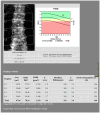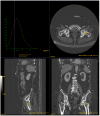Vertebral and Femoral Bone Mineral Density (BMD) Assessment with Dual-Energy CT versus DXA Scan in Postmenopausal Females
- PMID: 38786558
- PMCID: PMC11122249
- DOI: 10.3390/jimaging10050104
Vertebral and Femoral Bone Mineral Density (BMD) Assessment with Dual-Energy CT versus DXA Scan in Postmenopausal Females
Abstract
This study aimed to demonstrate the potential role of dual-energy CT in assessing bone mineral density (BMD) using hydroxyapatite-fat material pairing in postmenopausal women. A retrospective study was conducted on 51 postmenopausal female patients who underwent DXA and DECT examinations for other clinical reasons. DECT images were acquired with spectral imaging using a 256-slice system. These images were processed and visualized using a HAP-fat material pair. Statistical analysis was performed using the Bland-Altman method to assess the agreement between DXA and DECT HAP-fat measurements. Mean BMD, vertebral, and femoral T-scores were obtained. For vertebral analysis, the Bland-Altman plot showed an inverse correlation (R2: -0.042; RMSE: 0.690) between T-scores and DECT HAP-fat values for measurements from L1 to L4, while a good linear correlation (R2: 0.341; RMSE: 0.589) was found for measurements at the femoral neck. In conclusion, we demonstrate the enhanced importance of BMD calculation through DECT, finding a statistically significant correlation only at the femoral neck where BMD results do not seem to be influenced by the overlap of the measurements on cortical and trabecular bone. This outcome could be beneficial in the future by reducing radiation exposure for patients already undergoing follow-up for chronic conditions.
Keywords: DXA; bone mineral density; dual-energy CT; dual-energy X-ray absorptiometry; femoral neck fractures; osteoporosis; vertebral fractures.
Conflict of interest statement
The authors declare no conflicts of interest.
Figures








Similar articles
-
Opportunistic screening for osteoporosis using enhanced images based on dual-energy computed tomography material decomposition: a comparison with quantitative computed tomography.Quant Imaging Med Surg. 2024 Jan 3;14(1):352-364. doi: 10.21037/qims-23-855. Epub 2023 Oct 27. Quant Imaging Med Surg. 2024. PMID: 38223059 Free PMC article.
-
Assessment of volumetric bone mineral density of the femoral neck in postmenopausal women with and without vertebral fractures using quantitative multi-slice CT.J Zhejiang Univ Sci B. 2009 Jul;10(7):499-504. doi: 10.1631/jzus.B0820409. J Zhejiang Univ Sci B. 2009. PMID: 19585667 Free PMC article.
-
Opportunistic screening for osteoporosis using hydroxyapatite measurements of the vertebral by thorax dual-energy spectral CT in postmenopausal females.Sci Rep. 2022 Dec 14;12(1):21642. doi: 10.1038/s41598-022-26237-4. Sci Rep. 2022. PMID: 36517540 Free PMC article.
-
Discordance in lumbar bone mineral density measurements by quantitative computed tomography and dual-energy X-ray absorptiometry in postmenopausal women: a prospective comparative study.Spine J. 2023 Feb;23(2):295-304. doi: 10.1016/j.spinee.2022.10.014. Epub 2022 Nov 4. Spine J. 2023. PMID: 36343911
-
Comparisons of noninvasive bone mineral measurements in assessing age-related loss, fracture discrimination, and diagnostic classification.J Bone Miner Res. 1997 May;12(5):697-711. doi: 10.1359/jbmr.1997.12.5.697. J Bone Miner Res. 1997. PMID: 9144335
Cited by
-
Bone Mineral Density (BMD) Assessment Using Dual-Energy CT with Different Base Material Pairs (BMPs).J Imaging. 2025 Jul 13;11(7):236. doi: 10.3390/jimaging11070236. J Imaging. 2025. PMID: 40710622 Free PMC article.
-
Bone Mineral Density and Intermuscular Fat Derived from Computed Tomography Images Using Artificial Intelligence Are Associated with Fracture Healing.Bioengineering (Basel). 2025 Jul 19;12(7):785. doi: 10.3390/bioengineering12070785. Bioengineering (Basel). 2025. PMID: 40722477 Free PMC article.
References
-
- Francisco I., Nunes C., Pereira F., Travassos R., Ribeiro M.P., Marques F., McEvoy M., Santos M., Oliveira C., Marto C.M., et al. Bone Mineral Density through DEXA and CBCT: A Systematic Review with Meta-Analysis. Appl. Sci. 2023;13:5962. doi: 10.3390/app13105962. - DOI
-
- Harris K., Zagar C.A., Lawrence K.V. Osteoporosis: Common Questions and Answers. Am. Fam. Physician. 2023;107:238–246. - PubMed
LinkOut - more resources
Full Text Sources

